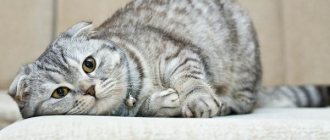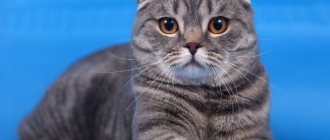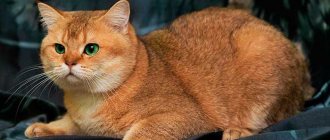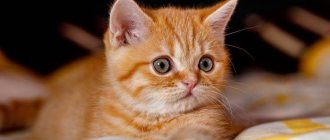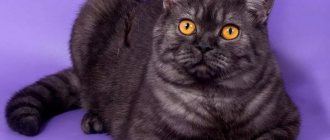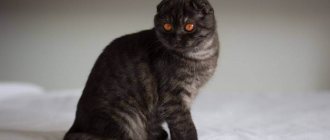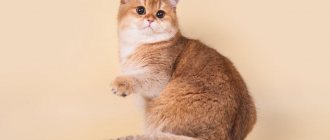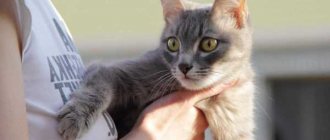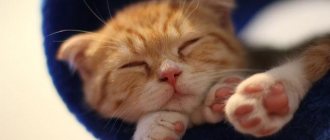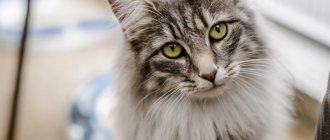It is difficult to argue with the fact that cats are currently the main favorites of the planet. Scottish cats had a hand in achieving this status.
This is a relatively new breed, the history of which goes back about 50 years. The first cat with floppy ears was discovered in Scotland, but for a long time this appearance was considered a defect. Despite the fact that people immediately appeared who appreciated the unique appearance, the breed was denied existence for a long time.
It’s hard to argue with the fact that cats are currently the planet’s main pets.
Everything was decided when Scottish fold cats appeared in the United States, where they became very popular. By 1980, breed standards were established, after which breeders around the world began to strive to breed a certain type of cat. The modern name for the Scottish Fold also appeared.
History of the origin of the Scottish Fold breed
The history of the origin of the Scottish Fold is quite unusual, because the breed was bred from a yard cat with long hair and unusually curved ears; at that time, this ear structure was considered a genetic mutation. In 1961, in Scotland, a shepherd interested in breeding cats noticed a white long-haired yard cat with an unusual ear shape. When the cat gave birth to kittens, he took one cat for himself, raised it and mated it with a British shorthair cat. As a result of this crossing, straight-eared and lop-eared kittens appeared.
Initially, the breed was simply called Fold; it received the Scottish prefix a little later in the place where it was bred. There are two types of the breed - short-haired and long-haired fold cats.
The breed was bred by a Scottish shepherd and got its name from the place where it was bred.
As a result of experiments with breeding Scottish fold cats, it was revealed that the mutation gene is dominant, which means that if one of the parents has the gene for folded ears, then kittens can appear with the same ears.
After some time, people in Scotland stopped breeding this breed out of fear that the mutation could have consequences in the form of ear infections or deafness in cats, which is why the breed was never officially recognized in Scotland. Active breeding of the breed began only in 1978 in the USA. In the same year, the breed was officially registered in one of the largest felinological organizations called CFA (Cat Fanciers' Association). The breed was never recognized by the International Federation of European Cat Breeding (FIFE) due to lop ears and associated mutations. But regardless of this, Scottish Folds are very popular in America and Australia.
Today, the Scots rank fourth in popularity among cat breeds, sharing it with the British Shorthair. The exotic cat, Persian and Maine Coon are ahead of them.
Description of the fold breed
Scottish Folds are usually medium in size. The height at the withers of an adult is from 20 to 30 cm. The body is elongated, flexible, the tail is medium or long, depending on the proportions of the cat’s body. Weight is only 1.5–2 kg. The breed's ears look like a folded envelope, but there are three types:
- ears pressed firmly to the head;
Ears that are pressed tightly against the head require frequent care.
- less flattened ears;
- folded just half of the auricle.
The head is perfectly round. The eyes are large, the color most often depends on the coat color and varies from blue to amber-brown. The coat is soft, plush, and short.
The colors of the Scots are very different: blue, lilac, black, white, two-color, for example, Whiskas color - gray and white stripes all over the body or red and white, multi-colored (tortoiseshell - a combination of white, red and black).
Photo gallery: Scottish Fold cat colors
The monochromatic chocolate color of the fold cat does not allow undercoat of a different shade
Tortoiseshell colors are found in cats; for cats, this color is a genetic failure
The name of the popular "Whiskas" color - gray and white stripes - comes from a food advertisement
Most often, the color of a cat's eyes depends on the shade of its fur.
Newborn white kittens are allowed to have spots on their fur, but adults must be perfectly white
The long-haired Scottish cat is similar to the short-haired cat: medium-sized body, long tail, ears pressed to the head, huge eyes. The weight of an adult cat is from 3 to 8 kg. The cat is distinguished by its long, beautiful hair, which makes it look like a big fluffy ball.
The Highland Fold has long and beautiful hair, which is why it looks like a big fluffy ball.
Character and behavior
Most often, most representatives of the breed are good-natured cats. But there are always exceptions to the rules - some fold-eared cats may have a wayward character, be unsociable, may not pay attention to the owner’s calls and may not even come up to be petted.
But in most cases, Scots love attention and affection, get along well in the family, get along with children and other animals, especially if they grew up together.
If you brought a new pet into your home, introduce them to the cat in doses so that the animals get used to each other and do not make each other want to fight.
Fold cats can treat strangers with caution and great caution, but once they realize that they are not in danger, they will easily make contact.
A fold-eared cat senses who its owner is, and it will not leave him even one step, in some cases it can even protect him from any danger. The breed is very active, loves to play with various teasing toys or simply chase a small ball or toy mouse. They can play on their own, but prefer human attention and participation in joint games. They also like to spend their rest next to a person, curling up in a ball and sometimes looking at what the person is doing.
Fold cats love to play, especially if the owner takes part in their games.
Diseases of the breed
The life expectancy of Scottish Fold cats is from 10 to 15 years. In order for your animal to live a long and healthy life, it is necessary to visit a veterinarian promptly, receive appropriate vaccinations, have joints checked, and follow the veterinarian's advice. The breed has some underlying health problems.
Hypertrophic cardiomyopathy
Hypertrophic cardiomyopathy is a hereditary heart disease. Symptoms:
- tachycardia;
- dyspnea;
- heavy breathing with wheezing;
- pulmonary edema;
- fainting;
- failure of the pelvic limb; in rare cases, both limbs may fail;
- high blood pressure.
The disease is diagnosed by measuring blood pressure at a veterinarian, undergoing echocardiography (data on the functionality of the heart is revealed), visual assessment, x-ray diagnostics, and electrocardiography. Animals in serious condition should be treated only in a hospital hospital, where there are all conditions for such cats. A veterinarian examines the animal’s condition and prescribes treatment, light physical activity and a special diet. If the animal feels better, it can be treated at home, unquestioningly following all the instructions of the treating veterinarian. The problem can be cured, but such cats will always have to be checked by veterinary cardiologists.
Degenerative joint disease
This disease is characterized by the fact that pain is present in the tail (most often) and the mobility of the limbs is reduced. Symptoms:
- obvious lameness;
- the cat’s reluctance to jump on chairs or sofas;
- it is difficult for a cat to get up from the floor after resting;
- frequent and prolonged licking of joints when washing;
- the cat becomes irritable and may hiss, scratch or bite.
The disease is treated with anti-inflammatory non-steroidal drugs; if the disease is advanced, antibiotics are prescribed. Additionally, a diet may be prescribed.
Osteochondrodysplasia
It is expressed in deformation of the paws, skeleton, and immobility of the tail. Symptoms:
- lameness (may pass and reappear, and an animal with illness will not be able to jump on high ground);
- squat appearance;
- stiff gait;
- acute reaction to touching the tail;
- severe deformation of the hind limbs;
- unsteady gait.
Treatment is aimed at eliminating symptoms with medication. In the absence of polycystic kidney disease, a non-steroidal anti-inflammatory drug can be prescribed; it will relieve the cat of pain and reduce inflammation. Additionally, vitamin complexes and special supplements are prescribed. In the UK, such sick cats undergo irradiation of their extremities; for a long time the cat can calmly walk, run and jump. In Russia there are no such technologies, so such operations are not carried out.
The disease often occurs when two fold-eared cats are crossed. From such parents there will be sick offspring with problems with the musculoskeletal system and skeletal structure.
Health issues
Since the British Folds were the result of interbreeding, the likelihood of genetic diseases among representatives of this feline species is very high.
British Folds are susceptible to genetic skeletal diseases
Thus, with age, osteochondrodysplasia may appear, expressed in lameness and deformation of skeletal bones (paws, vertebrae). This disease is incurable, so it is important to visit the veterinarian regularly if the kitten’s parents were two lop-eared individuals. If one of the parents had straight ears, the likelihood of pathology is significantly reduced.
In addition, British Fold cats are susceptible to typical diseases of all purring cats:
- viral infections (cat cold) - goes away on its own within two to three days, otherwise you should see a doctor;
- hypertrophic cardiomyopathy (heart pathology) - treatment is long-term (lifelong) and is supportive;
- polycystic kidney disease is an incurable disease; with maintenance therapy, cysts stop growing;
- claw fungus - can be cured with special antiseptic and antifungal solutions;
- infestation with parasites (worms, fleas) - preventive measures for deworming and getting rid of ectoparasites should be mandatory for representatives of the breed.
To maintain the health of your teddy pet, you must regularly visit the veterinary clinic for vaccinations. Vaccination begins at the age of 2.5 months and then every 3-6 weeks until the kitten is 15 weeks old.
This is followed by comprehensive annual vaccination against respiratory tract infections, panleukopenia, ringworm and rabies.
If you follow the rules for caring for your pet and carefully monitor the health of the British Fold, the animal will live up to 12–15 years.
Choosing a Scottish Fold kitten
If you want an animal for exhibitions and further breeding, then look for a kitten in elite nurseries. Most have websites on the Internet where you can see reviews, the animals themselves, information about the breeder and other useful things. If you just need a pet for the soul, then you can look for a pet on websites with advertisements.
Regardless of what purpose you need the animal for, first of all pay attention to the appearance and behavior of the kittens. Healthy kittens are active, with soft fur and non-running eyes. If the kitten is lethargic, then this is a sure sign of some kind of illness. Ask the breeder to show you the kittens' parents - you can roughly imagine what the kitten will look like in the future.
When choosing a kitten, you need to pay attention to activity: the more active the animal, the healthier it is.
Ask about the age of the kittens. The best age for selling offspring is 3 months, at this time the kittens are already quite independent: they eat, wash themselves, play and go to the toilet. Ask the breeder about documents: veterinary passport and pedigree (if available and you need).
The veterinary passport must contain notes on the animal’s vaccination, as well as notes on the treatment of the kitten for helminths.
If there are a lot of kittens, then watch them; the characteristics of their character or behavior will help you choose exactly the kitten that will suit you. When choosing a gender, think about it: if you want to mess with small kittens, then choose a cat - there are fewer problems with them, they will not mark every corner, unlike cats. If you want a cat, then be prepared for the fact that he may mark sofas, carpets or curtains. In addition, it is worth deciding whether you will spay/neuter your animal.
Prices for fold-eared kittens depend on the availability of pedigree, color and coat length. Long-haired Scottish Folds cost twice as much as short-haired ones. A kitten without a pedigree costs from 3 to 6 thousand rubles, with a pedigree - from 10 to 40 thousand rubles.
Distinctive features of this breed:
- soft plush fur;
- ears pressed to the head;
- unusual coat color;
- short hair in Scottish Folds, long hair in Highland Folds;
- small but elongated body, small tail;
- All kittens have blue eye color, the shade changes with age;
- at three months, the kitten weighs no more than 500 g, and its height at the withers is about 15 cm.
How to care for a kitten
When you bring your new pet home, make sure he has everything he needs. This includes:
- house;
- toilet;
- bowls for food and water;
- comb for cats;
- toys.
A small kitten requires increased attention to itself. In the first week he may be intimidated and unsociable, this is explained by the change of place, over time he will get used to it. At first, food, a house and a toilet should be nearby so that the animal does not get lost and make a puddle on the carpet.
The kitten should be fed in small portions, from 2 to 6 months at least five times a day. Clean, fresh, unboiled water should always be available. You can bathe the animal once every three or four months as it gets dirty, the ears should be cleaned as they get dirty, don’t forget about the eyes, from which tears can flow, they can be wiped with a cotton pad.
Scottish Fold ears need to be cleaned twice a week.
Once a quarter, the kitten must be treated against fleas, ticks and worms with special veterinary medications.
If desired, you can accustom your animal to brushing its teeth from a young age using a toothbrush and toothpaste for cats.
How to choose a name for a kitten
When coming up with a nickname for an animal, you should adhere to some rules:
- do not give the animal a long name;
- to choose a suitable nickname, observe the kitten, its character and activity - most often it is from these features that the name for the pet is invented;
- if you have a child, you can let him come up with a nickname for the cat, probably in the child’s memory there are many cartoon names that may suit your pet.
You can choose a name for a kitten based on its color. For example, a white girl can be called Snowball, Blondie, Jasmine, and a white boy can be called Snowball, Percy, Pooh, Marshmallow, Santa. A red-haired girl can be called Squirrel, Fox, Toffee, Sonya, a red-haired boy can be called Fox, Garfield, Ogonyok. With black cats, everything is generally simple, a girl - Blackie, Puma, Bagheera, Gloom, Voodoo, a boy - Morphy, Inferno, Motty, Mystic.
You can choose a name for a cat based on its coat color, for example, a red cat can be called Sonya, Ryzhulya, Fox
If you want to choose an unusual name for a kitten, you can use a special book with names for cats. Here are some examples of what you can call a fold-eared cat: Diana, Zabava, Auri, Bianka, Gabby, Aina, Gressy, Vasilisa, Holly, Erica, Laffey, Alice, Yanette. Names for the cat: Archie, Weiss, Douglas, Aston, Mustang, Baron, Woland, Chucky, Chip, Caesar, Quentin, Prince, Willis.
Life expectancy - how long do Scottish Folds live?
With excellent care, the Scottish Fold can live a long, active life. The average duration is from 15 to 18 years. Since the Scottish Fold is an artificially bred breed, the influence of genes on health, and therefore on life expectancy, is quite large. Unfortunately, the Scottish Fold is characterized by a tendency to a number of genetic pathologies. The kitten receives these diseases of the breed from its parents and earlier ancestors. That's why choosing a future pet should begin with getting to know its father and mother.
A proper lifestyle for the health of the Scottish Fold is extremely important. The pet must exercise enough and eat properly. In addition, injuries and stress should be excluded. If any problems arise, it is important to immediately contact a veterinarian in order to diagnose pathologies at an early stage.
Breed care
A fold-eared cat should be bathed no more than once every 3-4 months, or when it gets dirty. Use cat shampoo when bathing, after bathing, dry the cat with a towel and preferably dry it with a hairdryer, especially in winter, so that the animal does not catch a cold.
I bathe my cat once every three months, drying it with a hairdryer each time so that this wet creature does not fall onto a clean bed or get dust or other dirt on itself. Considering that my cat loves to lie in a large flower pot on the ground, drying with a hairdryer is a salvation from dirty paws and repeated bathing.
The fold-eared cat is the only one of all breeds that loves to be scratched against the grain. For combing, you can buy a comb with metal tips, but under no circumstances a slicker brush. A slicker can ruin the Scottish coat, and it will turn from plush to cotton wool, and the cat will lose its beautiful appearance. Long-haired cats need to be brushed once a day. Highland Folds do not like to swim, so once every 6 months will be enough.
Since the breed has floppy ears, cleaning should be done more often than regular cats. This is done twice a week using a cotton swab and ear drops for cats. The claws are trimmed as they grow back with special scissors; they remove the very tip of the claws.
When cutting, the main thing is not to touch the blood vessel in the claw.
cat litter
First you need to find a place for the cat litter box. Most often, owners choose a bathroom or toilet for these purposes; in some cases, it may be a corridor or landing on the stairs in a private house. For small kittens, the tray should be placed next to the house, and then, as they grow, you can move the tray to where it is convenient for you.
You also need to choose a litter tray for your pet. They come in three varieties:
- open with bars;
- open without grate, but with filler;
- Eurotoilet.
The Eurotoilet looks nice and is easy to clean
For a closed Euro-toilet you need a gel or silicate filler, their price is rather high, but the fillers block unpleasant odors, the tray itself looks nice, the filler does not scatter on the floor; The disadvantage of such a toilet is the large size of the tray, which may not fit in a small apartment.
A tray with filler is also very convenient: the tray itself is inexpensive, you can choose any filler for it according to your taste and wallet size, and it is convenient to change such a tray.
Ideal for cats - a large tray with filler
In my opinion, the most convenient filler is wood. You can find it in any store, it is inexpensive, and the filler lasts a long time. Absorbs liquid well, locking in odors. And cats find it more pleasant to walk on wood filler than on silicate balls or small pebbles.
For those people who are often at home and do not want to spend money on constantly buying fillers, we can recommend a simple tray with a mesh. It is convenient to rinse such a pot with water and wash it once a week with a chlorine-containing product to clean the tray and remove all odors.
To choose a filler, you often have to experiment. Each kitten has its own needs, some will like to use wood litter, some will like silicate litter, and some kitten will not like the litter and will only go to an empty tray with a grid.
This is exactly what happened with my cat. When I brought it home, I immediately put out a tray with wood filler. She showed him where his tray was and put him in it. The cat refused to go there for a day and endured it. Then I decided to remove the filler and leave the tray empty. I immediately went about my business and was pleased. So you should choose a toilet taking into account the cat’s characteristics and desires.
Feeding the fold breed
You need to feed the animal depending on its age:
- from 2 to 6 months - 5 times a day;
- from 6 to 8 months - three times a day;
- after eight months - twice a day.
The portion should be medium, you can find out its size by watching how much your pet eats. If the food is dry, then you can put more, the animal will still eat it later, but this option will not work with natural food, because it can turn sour throughout the day.
If you decide to feed your cat dry ready-made food, then it must be premium class, preferably for Scottish Folds. Dry food contains all the nutrients, vitamins and minerals that are useful and necessary for cats. Cats do not develop allergies to this food, and due to its balance, the cat quickly fills up with a small portion of dry food.
If you don’t want to give your cat dry food, you can feed it natural food. The diet should contain:
- sea fish;
- porridge;
- chicken;
- beef;
- turkey;
- cheese;
- cottage cheese;
- raw egg yolks;
- liver;
- vegetables.
It is not recommended to give to Scots:
- legumes;
- pork;
- potato;
- lamb;
- onion;
- milk;
- duck;
- sweet;
- salty and spicy foods;
Food from the human table should never be given to cats.
- salty preserves;
- chicken or fish bones;
- sausage;
- smoked meats;
- river fish;
- egg whites.
Sometimes I give my cat sour milk or a little yogurt. Such products can be given to fold-eared cats, but in small quantities and infrequently. It’s better to leave cheese as a treat, otherwise the animal will not want to eat porridge or vegetables when there is plenty of tasty cheese.
Maintenance cost
Privileged socialization and a comfortable life for the Scottish Fold in the house begin with the preliminary organization of the house and the acquisition of a basic set of cat accessories:
- Bed or house – 2000-3000 rubles.
- Tray - about 1500 rubles.
- Filler (clay or wood is recommended for kittens) – 280 RUR
- Bowls for food and water – 1000 rubles.
- Scratching post – 294 rub.
- Harness and leash for walking – 483 RUR
- Carrying – 660 rub.
- Toys - about 500 rubles.
Total: 11172 rub.
Nutrition
If an industrial diet is chosen, your pet will need four kilograms of dry food per month.
A two-kilogram pack of Natural Greatness “Field&River Recipe” food costs 1,986 rubles.
1986x2= 3964 rub.
When feeding with natural food, you will need about 7 kg of meat or offal worth about 2000 rubles.
Additional products will cost about the same.
2000x2=4000 rub.
Veterinary
The Scottish Fold should be taken to the veterinarian every year to assess its health. In addition, the animal is vaccinated annually with a complex vaccine, dewormed and protected against fleas and ticks.
- Medical examination of a young Scottish Fold on average (external examination, general blood test, selection of diet, recommendations) – 5,000 rubles.
- Vaccination (panleukopenia, rhinotracheitis, calcevirosis, chlamydia) – 1500 rubles.
- Comprehensive protection against helminths, fleas, ticks, ear mites - stronghold drug (drops on the withers) - 450 rubles. (the drug is applied 2 times a year)
Total: 7400 rub.
If Scottish Fold disease occurs, costs will increase significantly.
- Simple operation - from 20,000 rubles.
- Hospital stay – 5500
Total: 36,500 rub. 3 days in hospital + surgery
Grooming
The coat of the Scottish Fold needs to be cared for regularly, so you will have to purchase a small kit in advance for high-quality combing and bathing procedures. In addition, you will need to care for your ears, eyes, teeth, and claws:
- Fuminator FURminator for short-haired cats – RUB 1,976.
- Glove for combing cats – 178 RUR.
- Nail clippers with bottom lock – 193 RUR.
- Hypoallergenic shampoo for cats Elite Organic – 599 RUR.
- “Otokeya” ear lotion, cleansing – 195 RUR.
- Cliny eye lotion – 259 RUR.
Total: 3400 rub.
Exhibitions
The total cost of participation in the Scottish Fold exhibition depends on the size of the entry fee, the class of the event, how many cats will participate in the event, the number of days of presence, and transportation costs. Approximately, the costs of participating in the exhibition will look like this.
- Exhibition fee – 2500 rubles.
- Certificate from a veterinarian – 600 rubles.
- Preparation of the animal - 3000 rubles.
- Exhibition tent – 5000 rub.
- Folding tray, filler, bed, diapers, water, food - 3000-4000 rubles.
- Participation in rings and shows – 500 rubles.
Total: 15,600 rub.
Breeding Scottish Fold cats
Puberty in cats begins at approximately eight months. It’s best to skip the cat’s first heat, but on the second, after a year, you can safely pair her with a cat. If you have a fold-eared cat, then you should breed her with a straight-eared Scottish cat (Scottish Straight) to avoid health problems in the offspring.
Pregnancy in cats lasts 63–67 days. In Scottish cats, pregnancy proceeds well; cats at this time become lazier, sleep and eat more. Often, during estrus or pregnancy, fold-eared cats' ears rise slightly; over time, they fall into place; this phenomenon is not considered a flaw. A fold-eared cat can give birth to from one to seven kittens.
All offspring are born with straight ears, and it is possible to understand who will have fold ears only at 2–4 weeks of life.
Initially, all kittens are born with straight ears, and only by the age of two weeks can you understand which kitten will be straight-eared and which will have fold ears
Most often, Scottish cats are good and caring mothers. They raise their kittens, feed them, lick them, and over time teach them how to wash themselves, play, where to go to the toilet, and where to sharpen their claws.
Castration and sterilization
Sterilization and castration can be performed on both male and female cats, the difference is in the procedure itself. Sterilization involves ligation of the fallopian tubes in cats, and ligation of the seminal ducts for cats. The operation does not affect the sexual desire of animals, their instincts do not decrease or lose their intensity, animals can mate, but cease to bear offspring. Castration is the complete surgical removal of all reproductive organs: in cats, the ovaries are removed along with the uterus or just the ovaries alone; in cats, both testicles are removed.
An operation to sterilize or castrate an animal can be performed no earlier than puberty (8–10 months) and throughout its life. Not before maturity, because at a young age the reproductive system of animals is not yet fully developed and surgery can only harm their health.
After sterilization, cats require increased attention and proper care.
The operation is performed by a veterinarian under general anesthesia. The operation is short and quite simple. After the procedure, observation and care of the animal is necessary:
- Immediately after the operation, you need to monitor your pet, its breathing, and its general condition.
- Arriving home, the animal should be placed on a warm bedding away from windows and doors so that there is no draft.
- When the cat recovers from anesthesia, you need to put clean water nearby; you can feed it only a day after the operation in small portions and preferably with something liquid, like broth.
- Treat a cat’s wound with stitches for the first two days with brilliant green once a day, after that with Chlorhexidine two or three times a day, after 10–12 days the stitches are removed.
Owner reviews
- Oksana. We got a smart kitten - he opens his mouth to take medicine, knows the scratching post and the tray. From infancy he is accustomed to trimming his nails, knows how to follow some commands and is very attached to the child. In general, he is smart, playful, sociable, handsome and not picky. The Scottish Fold is an excellent pet.
- Kate. Our cat is a full-fledged member of the family. When I was little, I never walked and generally stayed away from people. At six months he became more affectionate: he came to be petted and slept next to him, but still on the sidelines. At one year old, he became completely attached to us, but he doesn’t let strangers get close to him. When guests arrive, he tries to hide, and especially does not tolerate children. You can't keep him home all summer. It sleeps in the beds, but if you bring it in from the street, it asks to come back. But, at the first cold weather, he spends all his time with us, loves to chat. We love him with our whole family. I highly recommend the Scottish Fold breed.
- Love. I don't know a simpler and more enjoyable animal to keep at home than the Scottish Fold. Since childhood, our Dusya was indifferent to windows and did not damage furniture or wallpaper. Now she sleeps peacefully at night, and not on our bed, but on her bed. Never hunts for legs. If she sees that the owners are not interested in her, she leaves so as not to irritate her, but will come when necessary. In addition, our cat is in excellent health. I consider my Dusya simply a gift of fate.
